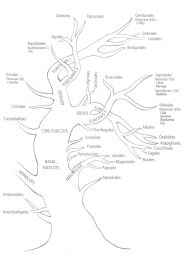As mentioned in the introduction, biochemical ecology is also a matter of space and time and therefore has to deal with questions such as ‘how and to where is coffee dispersed?’, ‘how long does it take for a seed (= coffee bean) to germinate?’, or ‘what happens during the transitions from a seed to a whole plant?’. Most of the results cited below were obtained by studies on arabica but, slightly modified, also apply to robusta.
The hobby gardener may seed a so-called ‘green’ (unroasted) coffee bean possibly available at the local coffee roasting company. By doing so, he or she has to bear in mind two things. First, the bean rapidly loses its germinating power when harvested and processed, depending on the bean humidity and on the temperature during storage. Generally, within 3 months after harvest and processing, the germination rate drops to zero, but is extended to one full year or longer at 18 °C, when the bean water content never falls below 40%, achieved by storing the beans vacuumpacked in a polyethylene bag (Valio, 1976; Couturon, 1980; Van der Vossen, 1980). Second, under natural conditions the coffee bean will not or very rarely get directly in touch with soil, because the seed-dispersing animals (monkeys, elephants, large birds) attracted by the red, fleshy and sweet coffee berries will, after having ingested them, excrete or regurgitate seeds still covered by the hard endocarp, so to speak a parchment coffee, as it also results technically from wet processing. Occasionally, the entire fruit is dispersed or drops beneath the coffee tree. Then, the berry will dry and shrink very slowly, looking like dry-processed coffee before hulling. The seeds within the shrunk fruit are even better protected and lose less water than in the parchment coffee. In any case, in nature under favourable conditions (humidity) the seed will take up water and germinate, breaking through the outer shell made up either of the parchment or the complete husk. Finally, going back to the hobby gardener, we have to add the following: the naked bean will germinate earlier (by around 2 weeks) than the bean in parch, but has a higher risk of being attacked by pests and pathogens in the soil during imbibitions (swelling) and germination. Even though caffeine is described as an effective agent (Table 1) against all kinds of organism (generalists), a few specialists have overcome the defence mechanism and not only detoxify but possibly also metabolize the PuA for their own needs.
Most interestingly, during water uptake (imbibition) caffeine remains almost completely fixed within the bean, very likely due to an efficient caffeine barrier at its surface made out of chlorogenic acids (Dentan, 1985). As will be outlined below, these phenolic compounds are of crucial importance during the entire life of the coffee plant, since they prevent autotoxicity by caffeine! Only when the radicle (the thick primary young root) grows into the substrate, is caffeine released at high concentrations into the environment (Baumann and Gabriel, 1984). Obviously, under natural conditions the imbibed bean is safely encapsulated – there is no need to excrete the defence compound caffeine – whereas during the later stages of germination about one-third of the caffeine of the young seedling, now exposed to pathogens and predators, leaks via the root surface into the substrate, where it may inhibit the competition by other plant species and prepare, along with other compounds, the way for specific root colonization by microorganisms.
As nicely illustrated in Figure 1, the emerging primary root is the first visible sign of germination. However, dramatic changes occur even earlier inside the bean: the tiny cotyledons invade the nutrient-rich storage tissue of the bean, the so-called endosperm, and eventually occupy the entire cavity within the bean. Simultaneously, the hypocotyl (the region of the stem beneath the stalks of the cotyledons) stretches and carries the head above the ground. Finally, the cotyledons unfold and shed the seed coat. Since during invasion into the endosperm they suck up all its constituents, cotyledons are, in simplified terms, a blot of the original coffee bean: they contain and conserve all the caffeine of the endosperm, and hence are most suitable for a screening to detect and select caffeine mutants (Baumann et al., 1998). Similarly, the chlorogenic acids are also transported into the cotyledons where, however, a large fraction is possibly used for lignin synthesis in order to mechanically stabilize the leaf tissue (Aerts and Baumann, 1994). Now the seedling is ready to develop into a plantlet.
Seed germination and seedling development. (©Yvonne Boitel-Baur, Zurich). This illustration shows the various stages from the bean in parch up to the emergence of the first foliage leaf pair.
First row from left to right: Germination, the primary root, and later, the hypocotyl emerge from the seed. Small lateral roots are formed and the hypocotyl extends to carry the ’head’ above the ground (ca 3 weeks).
Middle row from right to left: The apical hook straightens and the cotyledons (not visible) completely invade in and dissolve the endosperm (7 weeks).
Lower row left:
The cotyledons start unfolding, the remaining non-resorbed layer of the endosperm is shed, and subsequently the cotyledons fully expand (10 weeks). The first foliage leaves appear later.
In the upper left corner, coffee in parchment (upper row) and 'naked' beans are shown, with one of the latter with the silverskin partially removed.
germination

The 'Caffeines'
The
Caffeine Plants


